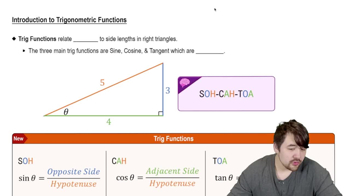Table of contents
- 0. Functions7h 52m
- Introduction to Functions16m
- Piecewise Functions10m
- Properties of Functions9m
- Common Functions1h 8m
- Transformations5m
- Combining Functions27m
- Exponent rules32m
- Exponential Functions28m
- Logarithmic Functions24m
- Properties of Logarithms34m
- Exponential & Logarithmic Equations35m
- Introduction to Trigonometric Functions38m
- Graphs of Trigonometric Functions44m
- Trigonometric Identities47m
- Inverse Trigonometric Functions48m
- 1. Limits and Continuity2h 2m
- 2. Intro to Derivatives1h 33m
- 3. Techniques of Differentiation3h 18m
- 4. Applications of Derivatives2h 38m
- 5. Graphical Applications of Derivatives6h 2m
- 6. Derivatives of Inverse, Exponential, & Logarithmic Functions2h 37m
- 7. Antiderivatives & Indefinite Integrals1h 26m
- 8. Definite Integrals4h 44m
- 9. Graphical Applications of Integrals2h 27m
- 10. Physics Applications of Integrals 2h 22m
3. Techniques of Differentiation
Derivatives of Trig Functions
Problem 3.5.42
Textbook Question
23–51. Calculating derivatives Find the derivative of the following functions.
y = tan x + cot x
 Verified step by step guidance
Verified step by step guidance1
Step 1: Identify the functions involved in the expression. The given function is \( y = \tan x + \cot x \). Here, \( \tan x \) and \( \cot x \) are trigonometric functions.
Step 2: Recall the derivatives of the basic trigonometric functions. The derivative of \( \tan x \) is \( \sec^2 x \), and the derivative of \( \cot x \) is \( -\csc^2 x \).
Step 3: Apply the sum rule for derivatives. The sum rule states that the derivative of a sum of functions is the sum of their derivatives. Therefore, \( \frac{d}{dx}(\tan x + \cot x) = \frac{d}{dx}(\tan x) + \frac{d}{dx}(\cot x) \).
Step 4: Substitute the derivatives of the individual functions into the expression. This gives \( \sec^2 x - \csc^2 x \).
Step 5: Simplify the expression if possible. In this case, the expression \( \sec^2 x - \csc^2 x \) is already in its simplest form.
 Verified video answer for a similar problem:
Verified video answer for a similar problem:This video solution was recommended by our tutors as helpful for the problem above
Video duration:
1mPlay a video:
Was this helpful?
Key Concepts
Here are the essential concepts you must grasp in order to answer the question correctly.
Derivatives
A derivative represents the rate at which a function changes at any given point. It is a fundamental concept in calculus that measures how a function's output value changes as its input value changes. The derivative can be interpreted as the slope of the tangent line to the curve of the function at a specific point.
Recommended video:

Derivatives
Trigonometric Functions
Trigonometric functions, such as sine, cosine, tangent, cotangent, secant, and cosecant, are functions of an angle that relate the angles of a triangle to the lengths of its sides. In calculus, understanding the derivatives of these functions is crucial, as they often appear in various mathematical models and applications.
Recommended video:

Introduction to Trigonometric Functions
Derivative Rules
Derivative rules, such as the sum rule, product rule, and quotient rule, provide systematic methods for finding the derivatives of complex functions. The sum rule states that the derivative of a sum of functions is the sum of their derivatives, which is particularly useful when differentiating functions like y = tan x + cot x.
Recommended video:
Guided course

Power Rules

 3:53m
3:53mWatch next
Master Derivatives of Sine & Cosine with a bite sized video explanation from Callie
Start learning




